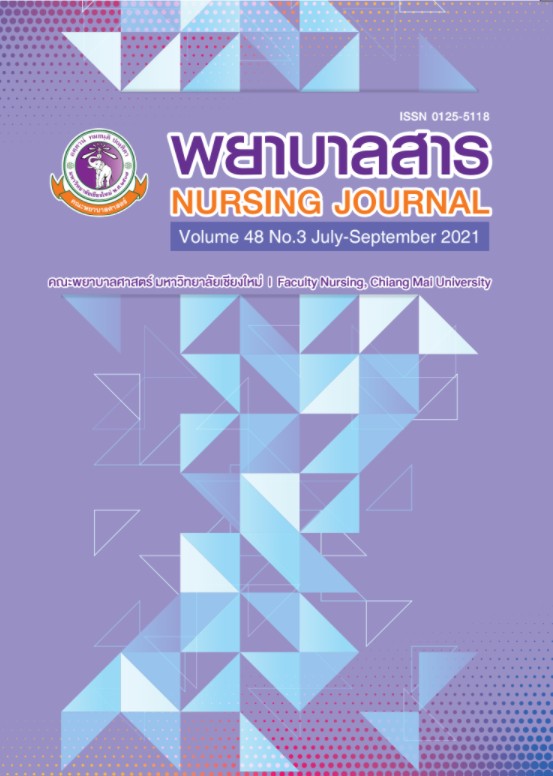Effect of Swaddled Bathing on Body Temperature of Preterm Infants
Keywords:
Preterm infant, Infant bathing, Swaddled bathing, Body temperatureAbstract
Daily bathing of preterm infants causes heat loss by means of convection, conduction, and evaporation, which can result in hypothermia. This study used a multiple time series design to study the effect of swaddled bathing on the body temperature of preterm infants. The sample consisted of 42 preterm infants at a post-gestational age of 34 to 36+6 weeks, hospitalized in the neonatal intensive care unit of a central hospital in the northern region. Samples were selected by means of purposive sampling. Samples were randomly assigned into an experimental and a control group, with 21 preterm infants per group. Research tools included a demographic data form and forms to record vital signs as well as the swaddled bathing clinical practice guidelines. Descriptive statistics, the Mann-Whitney U test, Fisher's exact test, an independent t-test, and one-way repeated measures ANOVA were used for data analysis.
The results revealed that the mean body temperature in preterm infants immediately after bathing, 10 minutes after bathing, and 20 minutes after bathing in the swaddle-bathed group was statistically significantly higher than in the conventionally bathed group (p < .05). The difference in the incidence of hypothermia between them was also not statistically significant (p > .05). The mean body temperatures of the swaddle-bathed group before bathing, immediately after bathing, and at 10, 20, and 30 minutes after bathing showed statistically significant differences (p < .05).
The findings of this study indicate that swaddled bathing can reduce heat loss in preterm infants more effectively than conventional bathing. Therefore, health care providers in neonatal intensive care units are able to apply swaddled bathing to reduce hypothermia during and after bathing preterm infants.
References
Çaka, S. Y., & Gozen, D. (2018). Effects of swaddled and traditional tub bathing methods on crying and physiological responses of newborns. Journal for Specialists in Pediatric Nursing, 23(1), e12202.
Chankhao. C. (2015). Newborn nursing. Bangkok: Chulalongkorn university printing house. (in Thai)
Edraki, M., Paran, M., Montaseri, S., Nejad, M. R., & Montaseri, Z. (2014). Comparing the effects of swaddled and conventional bathing methods on body temperature and crying duration in
premature infants: A randomized clinical trial. Journal of Caring Sciences, 3(2), 83.
Fern, D., Graves, C., & L'Huillier, M. (2002). Swaddled bathing in the newborn intensive care unit. Newborn and Infant Nursing Reviews, 2(1), 3-4.
Finn, M., Meyer, A., Kirsten, D., & Wright, K. (2017). Swaddled bathing in neonatal intensive care
unit. NeoReviews, 18(8), 504-506.
Hall, K. (2008). Practicing developmentally supportive care during infant bathing: Reducing stress through swaddle bathing. Infant, 4(6), 198-201.
Jirapaet, K. (2016). Newborn body temperature care. In S. Punanhitanon, S. Nonsueng, A. Limrangsikun, & N. Thongsawang (Ed.). Critical conditions in neonates (page 1-19). Bangkok: Active printing. (in Thai)
Jurica, S., Colic, A., Gveric-Ahmetaševic, S., Loncarevic, D., Filipovic-Grcic, B., Stipanovic-Kastelic, J., & Resic, A. (2016). Skin of the very premature newborn–physiology and care. Paediatria Croatica, 60(1), 21-25.
Katie, L. V. (2016). Newborn bathing method and effect on temperature regulation: A systematic review of literature. University of Wisconsin Oshkosh.
Kugelman, A., & Colin, A. A. (2013). Late preterm infants: Near term but still in a critical developmental time period. Pediatrics, 132(4), 741-751.
Kuller, J. M. (2014). Update on newborn bathing. Newborn and Infant Nursing Reviews, 14(4), 166-170.
Loring, C., Gregory, K., Gargan, B., LeBlanc, V., Lundgren, D., Reilly, J., ... & Zaya, C. (2012).
Tub bathing improves thermoregulation of the late preterm infant. Journal of Obstetric,
Gynecologic, & Neonatal Nursing, 41(2), 171-179.
Narumit. P. (2015). Adaptation of physiological knowledge in newborn care. Bangkok: Holistic publishing. (in Thai)
Pholanun, P., Kantawang, S., & Klunklin, P. (2013). Maternal participation in caring for preterm infants in neonatal intensive care unit and related factors. Nursing Journal, 40(1), 89-101.
(in Thai)
Quraishy, K., Bowles, S. M., & Moore, J. (2013). A protocol for swaddled bathing in the neonatal
intensive care unit. Newborn and Infant Nursing Reviews, 13(1), 48-50.
Sirikunsatian, W., Urharmnuay, M., & Klunklin, P. (2013) Pattern of stress responses among preterm
infants while receiving daily nursing care. Nursing Journal, 40(1), 127-139. (in Thai)
World Health Organization. (2017a). Preterm birth. Retrieved from http://www.who.int/mediacentre/factsheets/fs363/en/
World Health Organization (2017b). WHO recommendations on newborn health. Retrieved
from http://apps.who.int/iris/bitstream/10665/259269/1/WHO-MCA-17.07-eng.pdf?ua=1
Downloads
Published
How to Cite
Issue
Section
License
บทความที่ได้รับการตีพิมพ์เป็นลิขสิทธิ์ของวารสารพยาบาลสาร
ข้อความที่ปรากฏในบทความแต่ละเรื่องในวารสารวิชาการเล่มนี้เป็นความคิดเห็นส่วนตัวของผู้เขียนแต่ละท่านไม่เกี่ยวข้องกับมหาวิทยาลัยเชียงใหม่ และคณาจารย์ท่านอื่นๆในมหาวิทยาลัยฯ แต่อย่างใด ความรับผิดชอบองค์ประกอบทั้งหมดของบทความแต่ละเรื่องเป็นของผู้เขียนแต่ละท่าน หากมีความผิดพลาดใด ๆ ผู้เขียนแต่ละท่านจะรับผิดชอบบทความของตนเองแต่ผู้เดียว






